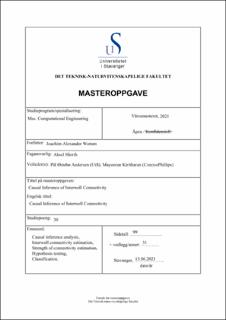| dc.description.abstract | Interwell connectivity is a measure of the degree to which information is translated between wells in a reservoir. The translated information may include changes in pressure, fluid flow, or other physical properties. This connectivity is separated into internal connectivities (through the reservoir) and external connectivities (through the infrastructure). Understanding these interwell connectivities may improve the overall understanding of the reservoir, aid in optimizing oil and gas production, and avoid new and undesired connectivities.
We seek to determine if causal inference can be applied to aid in the detection of interwell connectivities within the oil and gas field, Eldfisk, operated by ConocoPhillips. Eldfisk is a mature field with a complex network of injection and production wells and a large and connected infrastructure of oil and gas installations. We examined thirteen wells, where eight are water injection wells, and five are oil and gas producing wells. Between these, there are three injection to injection well connectivities and five injection to production well connectivities, for a total of eight well-pair connectivities. These connectivities are known to ConocoPhillips and have been identified through various methods, including manual comparison of pressure responses between wells. The connectivity we seek to identify is a pressure response between a stimulating well and a target well through the reservoir. Data is obtained from Bottom Hole Pressure sensors where this is available and Tubing Head Pressure sensors otherwise. The pressure data is split into smaller datasets that target periods when a stimulating well is experiencing a change in pressure. These periods are identified by an on/off indicator, binary data indicating whether a well is opened or closed. Every well is given status as a stimulating well for each period identified by the on/off-indicator. All other wells are considered as target wells during these periods. Two different causal inference methods were applied to the datasets; Peter Clark Momentary Conditional Independence + (PCMCI+) and Temporal Causal Discovery Framework (TCDF). PCMCI+ is a method that employs partial correlation to infer causality, and TCDF employs convolutional neural networks. We found that the PCMCI+ algorithm was able to identify seven out of eight well-pairs with known connectivities. However, it was less precise, with approximately one out of five identified connectivities being true. The TCDF-algorithm identified three out of eight well-pairs with known connectivities. This model was more precise, with approximately one out of four identified connectivities being true. We also found that the overall complexity of the original dataset was effectively reduced by splitting it into smaller datasets. These datasets specifically targeted periods when the wells experienced changes in their pressure profiles. External interferences from a field-wide water supply were not effectively reduced and were a cause of a majority of false connectivities. Group-wide interference from wells sharing the same production installation was found to be effectively reduced. Using tubing head pressure data when bottom hole pressure data was unavailable, was found to be an effective substitute. | |
